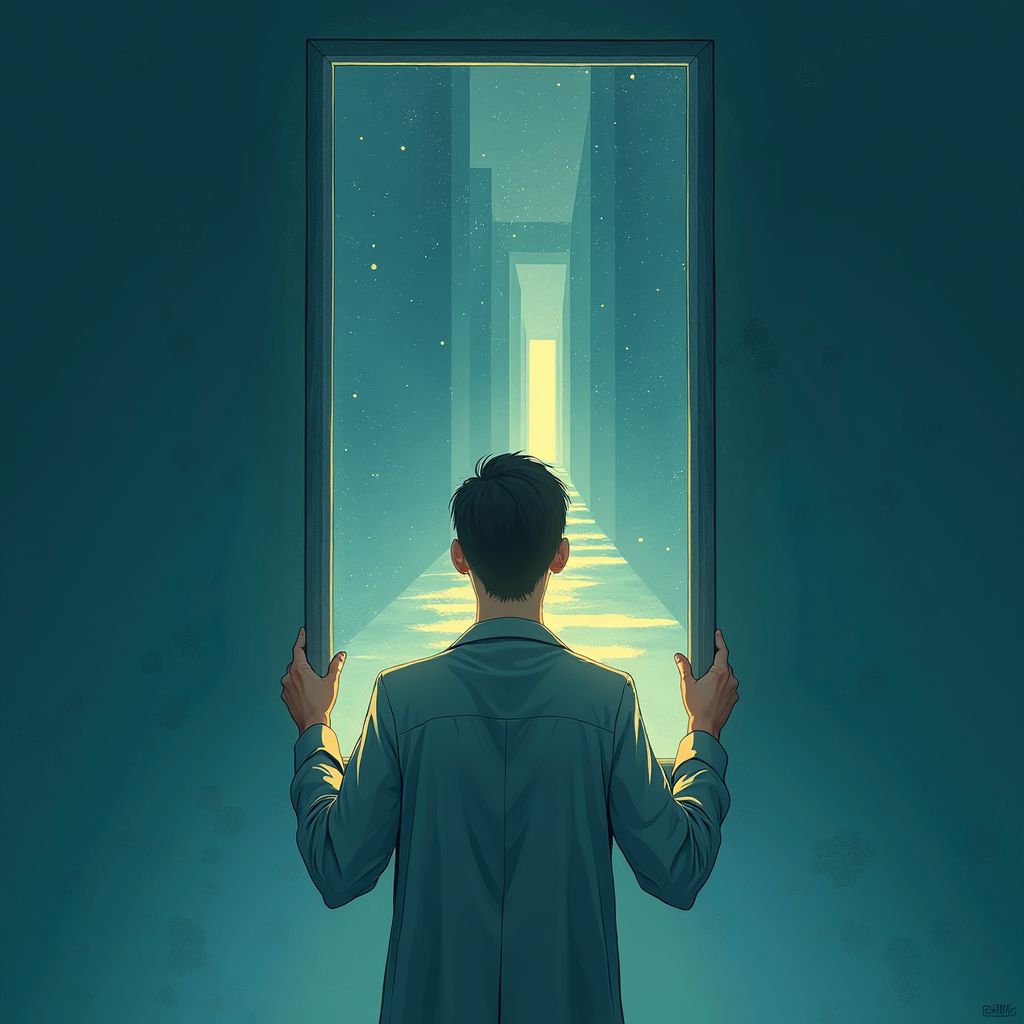Some days, scrolling through social media feels like stumbling through a hall of mirrors—distorted reflections everywhere. Last Tuesday, I caught myself envying a stranger’s vacation to Bali... only to spot the same palm trees in three separate profiles, each claiming a different story. It made me wonder: how much of what we see online is just painted shadows? Two thousand years ago, Plato seemed to have predicted our predicament, and his allegory is shockingly relevant today. Let’s step into the cave—and see what’s really at play behind our screens.
Behind the Screens: The Cave All Around Us
Step back for a moment and picture Plato’s Allegory of the Cave. It’s an ancient story, but its relevance today is almost uncanny. Imagine people chained in a dark cave, only able to see shadows flickering on the wall in front of them. These shadows are all they know of reality. They talk about them, form opinions, and even argue about what they see. But the truth? It’s happening behind them, out of sight, beyond their understanding.
Now, consider your daily scroll through social media. The endless stream of updates, photos, and opinions—each carefully selected, filtered, and presented. It’s easy to feel like you’re in the loop, like you see the world as it truly is. But research shows that, much like Plato’s prisoners, you’re often only seeing shadows—reflections of reality shaped by algorithms, biases, and the choices of others.
Plato’s Allegory of the Cave: An Ancient Model, Fresh Relevance
Plato’s allegory isn’t just a philosophical exercise. It’s a warning about mistaking appearances for truth. The cave’s shadows are illusions, and the real world exists outside, waiting for those willing to turn around and seek it. Today, the cave’s walls are digital screens. The chains? They’re the habits, notifications, and dopamine hits that keep you coming back for more.
Studies indicate that social media platforms thrive on keeping you engaged, often by showing you content that aligns with what you already believe or enjoy. This creates a feedback loop—one that feels comfortable, but can be deeply misleading. You may think you’re informed, but are you really seeing the whole picture? Or just the shadows that others want you to see?
Social Media as the New Cave: Shadows, Chains, and Carefully Curated Walls
Social media is designed to be immersive. The algorithms behind your feed are powerful, but not always transparent. They decide what you see, what you miss, and even how you feel about the world. Filter bubbles—a term used to describe the narrowing of your online experience—are the modern equivalent of the cave’s walls. They keep out the unfamiliar, the uncomfortable, and sometimes, the truth.
Research shows that these digital walls reinforce your existing beliefs. You see more of what you like, less of what challenges you. It’s easy to forget that there’s a world outside your feed, full of perspectives and realities you might never encounter unless you make a conscious effort to look for them.
“We can easily forgive a child who is afraid of the dark; the real tragedy of life is when men are afraid of the light.” —Plato
This quote, though centuries old, echoes in every corner of the internet. The comfort of the cave—the curated, filtered, and familiar—can be hard to leave. But staying there means missing out on the complexity and richness of the real world.
The Comfort (and Trap) of Feeling ‘In the Know’ Online
There’s a certain satisfaction in feeling informed. Social media gives you that in spades. You see breaking news, trending memes, friends’ milestones. It’s a rush—a sense of connection and awareness. But is it real? Or just another shadow on the wall?
Studies indicate that the illusion of being ‘in the know’ can be powerful, even addictive. The more you scroll, the more you feel like you’re part of something bigger. Yet, this comfort can be a trap. You’re seeing what’s popular, not necessarily what’s true or important. The lines between reality and illusion blur, and it becomes harder to tell what’s genuine.
The truth is, social media often presents an idealized version of life. People share their highlights, not their struggles. News is sensationalized, not nuanced. The result? A distorted sense of what’s normal, what’s possible, and what’s real. You might feel connected, but research shows that this can also lead to anxiety, comparison, and a sense of isolation.
So, as you navigate your digital world, it’s worth asking: Are you seeing reality, or just the shadows on the wall? The answer isn’t always clear—and that’s exactly why Plato’s cave still matters, perhaps more than ever.

The Chains and Shadows: Filter Bubbles, Algorithms, and Illusions
Imagine sitting in a dark cave, watching shadows flicker on the wall. You’ve never seen the world outside, so these shadows become your reality. This is the heart of Plato’s Allegory of the Cave, and it’s a powerful analogy for how social media shapes your perception today. The difference? Instead of stone walls, you’re surrounded by invisible chains—algorithms and filter bubbles that quietly decide what you see, think, and believe.
Algorithms: The Invisible Chains
Every time you scroll, click, or like, social media platforms are watching. Not in a sinister, movie-villain way, but in a calculated, data-driven fashion. Algorithms learn from your behavior, then serve you more of what you already engage with. Over time, these algorithms become invisible chains, subtly guiding your experience. You might think you’re in control, but the reality is more complicated.
Research shows that these algorithms are designed to maximize engagement, not to broaden your horizons. If you click on certain types of news, memes, or videos, you’ll see more of the same. It’s efficient, but it’s also limiting. You end up seeing a narrow slice of the world—one that reflects your existing beliefs and preferences back at you, over and over.
“Social media creates a distorted sense of reality by reinforcing existing biases and exposing users to limited perspectives, similar to prisoners in Plato’s cave.”
You might not notice the chains at first. They’re quiet, almost comforting. But as time goes on, they tighten, and your worldview narrows. The world outside the cave—the full spectrum of ideas and experiences—becomes harder to see.
Filter Bubbles: Echoes of Yourself
Why do you keep seeing the same opinions, the same jokes, the same outrage, day after day? That’s the filter bubble at work. A filter bubble is what happens when algorithms only show you content that matches your interests and beliefs. It’s like living in a hall of mirrors, where every reflection is just another version of you.
Studies indicate that filter bubbles can warp your sense of reality. When you’re only exposed to one side of a story, it’s easy to believe that’s the whole truth. Dissenting voices fade into the background, or disappear entirely. Over time, your sense of what’s normal, true, or important becomes skewed.
This isn’t just an abstract problem. It affects how you see the world, how you relate to others, and even how you vote or make decisions. The more you stay inside your bubble, the more the outside world feels foreign, confusing, or even threatening.
Digital Shadows: The Illusion of Perfection
There’s another layer to these digital illusions. Scroll through your feed, and it seems like everyone is happier, thinner, more successful. Their vacations are sunnier, their relationships are sweeter, their lives are just… better. But this isn’t reality—it’s a carefully curated highlight reel.
Research shows that social media often presents an idealized version of life. People share their wins, not their losses. They post filtered photos, not the messy moments. The result? You end up comparing your real life to someone else’s digital shadow. It’s no accident that this can lead to feelings of inadequacy, anxiety, or even depression.
“Social media highlights often present a curated, idealized version of reality, which can mislead users about actual life experiences.”
It’s easy to forget that these images are just shadows—distorted, incomplete, and sometimes entirely fabricated. But when you see them every day, they start to feel real. The cave’s shadows become your truth, even as the real world waits outside, just beyond reach.
The challenge, then, is to recognize these chains and shadows for what they are: illusions crafted by algorithms and amplified by filter bubbles. Only by questioning what you see—and seeking out new perspectives—can you begin to glimpse the world beyond the cave.
Out of the Cave: Critical Thinking and Escaping Digital Illusions
Every time you scroll through your social media feed, you’re stepping into a modern version of Plato’s cave. In the original allegory, prisoners mistake shadows on a wall for reality, never realizing there’s a world beyond their limited view. Today, those “shadows” are the curated posts, viral trends, and algorithm-driven content that shape your perception—often without you even noticing. The challenge is learning to spot these digital illusions and, more importantly, to step out of the cave.
Let’s start with the basics: how do you recognize a “shadow” online? It’s not always obvious. Research shows that social media platforms are designed to reinforce your existing beliefs, creating what’s called a “filter bubble.” You see more of what you already agree with, and less of what challenges your perspective. This can make it feel like everyone thinks the same way you do, or that certain lifestyles are more common than they really are. The first step to escaping these illusions is to pause and ask yourself: Is what I’m seeing the whole picture, or just a carefully chosen slice?
A practical daily reality check can be as simple as diversifying your information sources. Follow people with different backgrounds, opinions, and experiences. When you come across a post that triggers a strong emotion—whether it’s outrage, envy, or even joy—take a moment to investigate. Is the story backed by credible evidence? Are there alternative viewpoints? Studies indicate that critical thinking skills are essential for navigating the digital world, helping you distinguish between genuine insight and cleverly packaged misinformation.
Now, imagine if Plato had a smartphone. Would he get lost in the endless scroll, or would he use it as a tool for enlightenment? It’s an amusing thought, but it highlights a key point: you need mental models to resist the pull of social media illusions. One useful model is the “outside view.” Instead of judging a situation based on your immediate feelings or the information right in front of you, step back and consider the broader context. Ask yourself: How likely is this to be true, given what I know about the world? This habit helps you see beyond the shadows and recognize the reality behind the screen.
Another helpful approach is to practice digital skepticism. Don’t take every viral post at face value. Algorithms are designed to maximize engagement, not accuracy. If something seems too good (or too outrageous) to be true, it probably is. By questioning what you see and seeking out diverse perspectives, you begin to chip away at the walls of your own digital cave.
Of course, escaping the cave isn’t just about information—it’s also about experience. I once had a friend who was convinced she was missing out on life. Every weekend, her feed was filled with photos of parties, trips, and seemingly perfect moments. She started to believe that everyone else was living more fully than she was. Then, she tried something radical: an “unplugged weekend.” No social media, no scrolling, just real life. The result? She realized that most of those online highlights were just that—highlights, not the whole story. Real life, with all its ups and downs, was still happening off screen.
This anecdote isn’t unique. Research shows that constant exposure to idealized portrayals online can increase anxiety and depression, making it even more important to step back and reconnect with reality. The digital world is powerful, but it’s not the only world. By practicing critical thinking, questioning your assumptions, and occasionally unplugging, you can escape the shadows and see life as it truly is.
In the end, Plato’s cave isn’t just a story from ancient philosophy—it’s a warning for the digital age. The shadows on your screen aren’t always reality. With a little effort, a healthy dose of skepticism, and a willingness to look beyond the obvious, you can step out of the cave and into the light. The real world, with all its complexity and nuance, is waiting for you.
TL;DR: Social media often projects illusions rather than realities, much like Plato’s prisoners watching shadows on a wall. To break free, you must question appearances, seek diverse perspectives, and embrace critical thinking—remember, there’s always life beyond the shadows of your screen.



